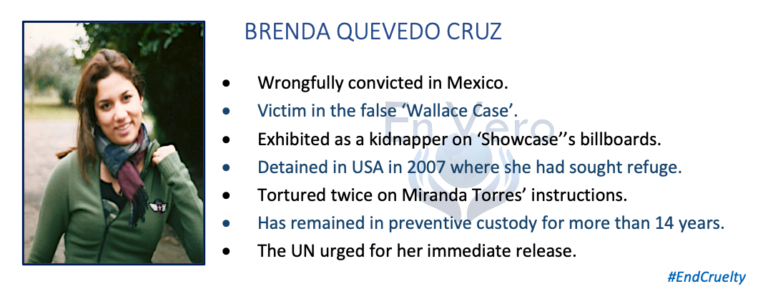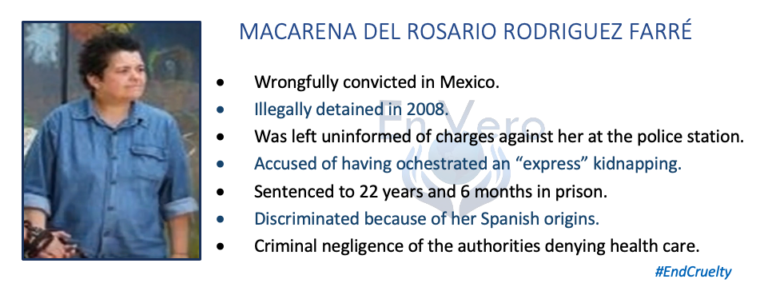Source: Proceso
Author: José Reveles
September 24, 2017 (Original publication in Spanish on June 16, 2016)
Translation: Jorge B.
Four and a half centuries in prison for alleged kidnapper of Fernando Martí … without any evidence.
Pablo Solórzano Castro was sentenced to nearly five hundred years in prison. The charge? Supposedly he participated in the kidnapping and murder of young Fernando Martí. The problem? The agents who arrested him were the same ones who had blackmailed him two years before, the sentence was based on the saying of a single protected witness (the same one who “fabricated” culprits in other 80 cases), the accused was tortured, the judge accepted originally invalid evidence but refused any evidence from the defence… That’s how “the law was administered” in a case that lasted twelve years.
The maxim testis unus, testis nullus established in Roman law centuries ago that a sole witness is not a witness at all. Especially if there is not a single additional element of evidence that corroborates an accusation, that makes it categorical and convincing; and if there is not any other formal accusation from anyone else against the accused.
Something so logical and elemental does not work like that in the Mexican justice system, in that factory of culprits that saw no change in the ruling party in 2012, in that machine crushing innocent people using false witnesses that operated in the Acción Nacional administrations and continues full steam ahead in the current PRI government.
Pablo Solórzano Castro was arrested on May 12, 2011, by the same federal agents who in October 2010 tried to extort from him half a million pesos so as not to involve him in one of the country’s most dramatic cases of kidnapping and murder, the case of Fernando Martí Haik.
How Pablo was made to fit into the framework of the so-called Banda de la Flor and into that of Los Petriciolet was as simple as it was wicked: it was enough to get his picture, in black and white, from Plataforma México (the Mexican government’s largest criminal database) and take it to one of the most prolific witnesses created by García Luna Productions, someone equally accused in the Martí case, Noé Robles Hernández, nicknamed El Chimuelo (The Toothless one). This is what was happening on December 11, 2010, in the high security prison of the Altiplano.
By then, Noé had made 12 official statements, in none of which he had ever mentioned the name of Pablo Solórzano Castro; statements he made before the authorities in July, September, November and December 2009; and March, April and September 2010.
But from then on Noé fantasized, as he did in about 80 cases in which he participated as an accusing witness protected by the government. He said that Pablo was nicknamed El Gallo (The Rooster) and described him in a way that did not resemble at all the picture that the police and a federal public prosecutor in vain had tried to make him memorize.
Based on the testimony of that accuser and only witness, Pablo was sentenced to 452 years, 8 months and 25 days. It was enough for the prosecution to assume that Pablo had been part of the squad group at a fake Federal Investigation Agency checkpoint that stopped the armoured car in which the young Martí, accompanied by driver and bodyguard, was traveling on the morning of June 4, 2008. After tortuous negotiations with the kidnappers, businessman Alejandro Martí sent over 5 million pesos to his son’s kidnappers, who accepted the deal and offered to release him. However, the body of the young man was found shot dead in a trunk of a Corsa car, plate 130-SUJ, in the borough of Coyoacán on August 1, 53 days after being kidnapped.
The Phantom Message
The sole testimony of the singular witness Noé Robles Hernández (who also called himself Noé Abraham Soto García) points out Pablo Solórzano as having been at the fake checkpoint and of having handwritten the message on a cardboard that was next to the corpse and read: “For not paying, sincerely the family” [sic]. Apparently some members of the group of kidnappers stole the money or part of the ransom.
But the cardboard, if it really existed, is not even on file, so it is impossible to do the handwriting tests that have been demanded by the defence, the parents and the sister of the accused. In more than four and a half years the authorities never gave Pablo the results of an alleged handwriting analysis performed to compare his writing with those of the phantom cardboard.
Although there is no evidence “or circumstances of time, mode and place of my alleged participation” (in the kidnapping of the young Martí), “they make up an alias and sentence me, without any other link such as money, weapons or any other type of evidence,” Pablo says in his pleading. Solórzano Castro claims to be absolutely innocent of having had the slightest contact with the kidnappers and much less to have participated in the Martí case.
When he was arrested in Coacalco, state of Mexico, his captors took 15 hours to hand him over to the Public Prosecutor’s Office. During that time he was tortured to force him to plead guilty. As a lawyer, Solórzano knew that his statements made to police officers were not valid, much less under torture and threats to his family, so he “confessed” to prevent further torture. They made him sign self-incriminating prewritten statements. The pressure was such that six days after his arrest he attempted suicide, according to information in the case file. Psychologist Marisela Campos Velázquez examined him according to the parameters of the Istanbul Protocol and found indications of torture, including acute post-traumatic stress.
Based on the accusations of the sole witness, Nadia Villanueva Vázquez, the First District Court judge in Federal Criminal Proceedings of the State of Mexico, sentenced Pablo to the disproportionate and unusual sentence of 452 years, 8 months and 25 days for his alleged and vague participation in the kidnapping of young Martí, for organized crime and possession of ammunition.
Proceso magazine has in its possession 89 single-spaced, legal-sized pages of the prisoner’s allegations, who as a graduate lawyer is his own defender, and those of the lawyer Luis Monroy Moreno, in which they indicate the grievances about the case and the irregularities in it, and request the overturn of the brutal sentence to be replaced by an acquittal. This request is based on the judge’s total dismissal of the defence’s evidence provided by Pablo, on her not taking into account that he was tortured and not providing a single element of evidence beyond the accusing finger of Noé Robles Hernández.
The present article had already been written when, on May 25, 2016, Judge Angelica Marina Pérez, of the Second Unit Court of the Second Circuit, decided to revoke the obviously exaggerated sentence in a case that shows too many reasonable doubts. Having had this sentence set aside, Pablo Solórzano can continue to provide evidence of his innocence since the huge sentence simply is not longer valid and the trial can go on.
Confessed accuser
Incidentally, Noé gave Pablo Solórzano a handwritten note that begins by saying (respecting the syntax of the original text):
“You came to Cefereso, I met you and I knew that I did wrong but I was forced to, but I must tell you again I know that you understand me because you got to know José Manuel Rojas Cruz and suffered ill-treatment from him, I’m sure you know well how they act, not only him but all those who are making up this story, from the now former federal policemen to Luis Cárdenas Palomino and all the officers from the Public Prosecutor’s Office…”
In October 2010, businessman Alejandro Martí, president of the México SOS association, published the photographs of the participants in the kidnapping of his son. Among these, there were 17 people subject to criminal proceedings;however, several alleged participants in the kidnapping, captivity and death of Fernando were still fugitives.
In the photos there appear the former judicial agents of the Federal District Oscar Morales Alvarado, alias El Alvin or El Chiquito; Raúl Jaime Santamaría Méndez, alias El Santa or El Pacholín; the former federal policeman José Martín Jiménez Martínez, alias El Porro or Vitorio; and Luis Manuel Castillo Rentería, alias La Botarga or Brazos Cortos.
For its part, the PGR offered 15 million pesos in rewards for the capture of these fugitive individuals, among whom the name of Pablo Solórzano Castro did not appear. And, of course, not even among the detainees, because he was not captured until May 2011, curiously enough by federal agents who handled details of the Martí case and to whom it was an easy task to involve Solórzano but who failed to provide hard data to prove his participation.
Pablo was placed at the disposal of the Public Prosecutor José Manuel Rojas Cruz, through a document signed by federal police officers Ismael Zarco Cruz, Sergio David Frutero Salcido, Ricardo Muñoz Tapia and Jesús Isaac González Torres. Not all the participants in the capture (about 25 agents) were included, nor all those named were involved in the arrest without court order, although they were involved in the extortion attempt.
Agents Fernando Morales Soriano and Alfonso Olmedo Villarreal were in charge of physically and psychologically pressuring Noé Robles Hernández to identify the individual in the photograph as El Gallo Pablo Solórzano Castro.
The curious thing about this episode is that José Manuel Rojas Cruz, the same public prosecutor that would bring Pablo to trial and had the photo from Plataforma México obtained by police Morales Soriano, signs as an “assistance witness.” The proceedings took place inside the Altiplano high security prison; however, its director, following a specific request to her for information, responded in writing:
“He signed but was not there.”
“After a thorough search was carried out in the archives of this administrative unit, no record was found that the inmate Noé Robles Hernández had visits on December 10 and 11, 2010, from José Manuel Rojas Cruz,” she added
It is impossible for anyone to go in to interrogate a prisoner without checking in and out, as ordered by prison protocols. That is to say, the signature in the official minutes by Rojas Cruz, the one that would arrest Pablo Solórzano, was a forgery. This is ”illicit evidence” admitted by a judge.
There are statements from Noé Robles stating that since 2009 “the nickname of El Gallo was mentioned to me” (in jail), among others by the federal police officer Alfonso Olmedo Villarreal and the agent from the Federal Public Prosecutor’s Office José Manuel Rojas Cruz. In December 2010, both pressured him to recognize El Gallo as Pablo Solórzano, with the help of other agents from the Prosecutor’s Office such as Ramón Estrada Rodríguez and Gualberto Ramírez Gutiérrez (the latter, head of the SEIDO’s Anti-Kidnapping Unit).
In a document registered on December 19, 2013, as part of the investigation file (PF/ DINV/ EJ/19840/2013), the Inspector General of the Federal Police Victor Hugo Orozco Padilla wrote:
“In the office of the head of this investigation division there is no previous record or any record as to the existence of any indication, data, file or record that Pablo Solórzano Castro has been identified with any alias or as a member of any criminal group; or whether he has any links within any structure or organization chart of any criminal organization, specifically with Los Petriciolet or La Flor, prior to December 11, 2010.”
The case was fabricated from a photographic print and a supposed identification made by a sole testimony. There was no one single expert opinion to support the prosecution. There was no confrontation procedure followed, just identification through the chamber of Hessel, where there was only one person present: Pablo. The ruling was “arbitrary and discretionary,” the defence contends. The judge dismissed all the evidence of the accused and called the evidence “not beneficial, irrelevant and unlikely to be taken into consideration.”
More importance was given to a photo extracted from Plataforma México than to the accumulation of evidence of innocence presented by Pablo, which the judge called “irrelevant.” The photo extracted by police officer Fernando Morales Soriano was given to the agent of the Federal Prosecutor’s Office José Manuel Rojas Cruz and later shown to the presumed witness in prison Noé Robles to inculpate Pablo Solórzano. The accusation had been in the making for six years.
The Martí case had already taken a bizarre turn when two female police officers were accused of the same and exact crime, to have been part of a false roadblock to kidnap Fernando Martí. One of them, federal agent Lorena Gonzalez nicknamed La Lore, was captured by the authorities of the Federal District, and the other, Maria Elena Ontiveros Mendoza nicknamed La Güera, by federal officers. La Lore was in prison for almost 7 years. In July 2015, she was released, as she was ruled innocent.
In that struggle between local police and federal police, both identified as infiltrators by kidnappers, Pablo Solórzano, an ideal victim of federal extortionists for having been an agent of the Office of the Attorney General of the Federal District, including a bodyguard for Attorney General Bernardo Bátiz, may have been caught.
Although he ignores who turned him into a scapegoat, Pablo Solórzano proclaims his innocence and the complete lack of credibility of an inmate who, in agreement or forced by the federal government, has been “a witness” in about 80 cases, perhaps only surpassed by Jennifer, another “paid witness” highly protected by the government of Felipe Calderón. Jennifer, who is the lawyer Roberto López Nájera, lives in the United States and is today a DEA informant.
All those falsely accused by Jennifer are free: former Federal Police commissioner Javier Herrera Valles, former deputy prosecutor Noé Ramírez Mandujano, former Federal Police commissioner Victor Gerardo Garay Cadena, former directors of Interpol Rodolfo de la Guardia and Ricardo Gutiérrez Vargas, army generals Tomás Ángeles Dauahare and Roberto Dawe, the PRD’s former mayor of Cancún and governor candidate for Quintana Roo, Greg Sánchez, among many others out of his unlimited imagination and the orders of the then leaders, the creators of convenient culprits.





